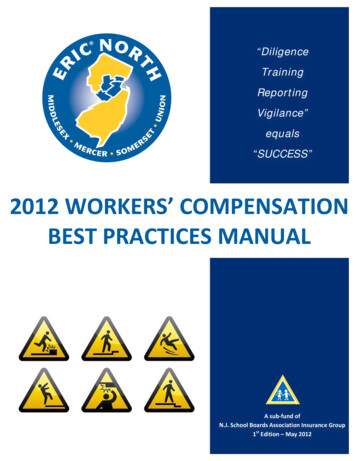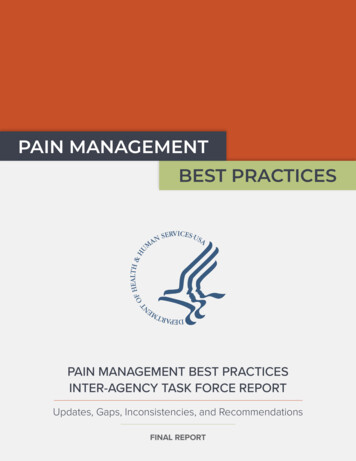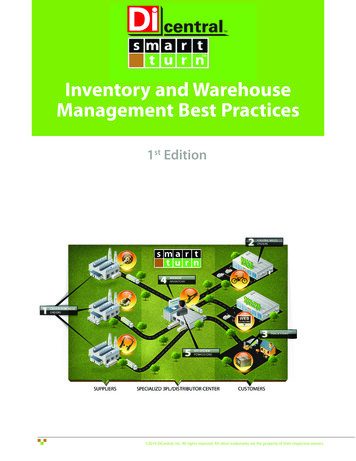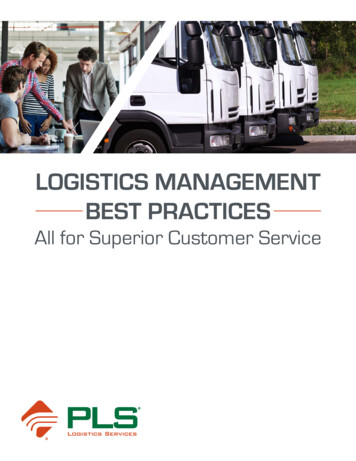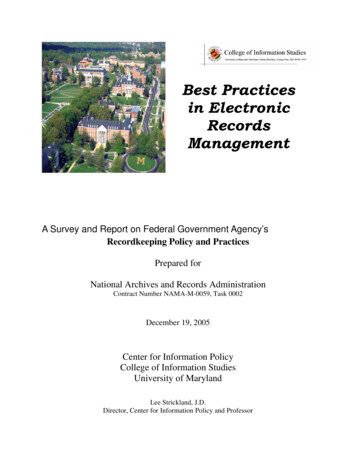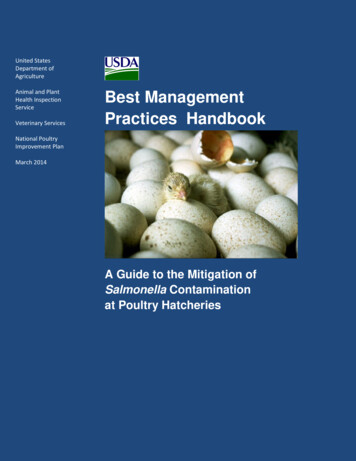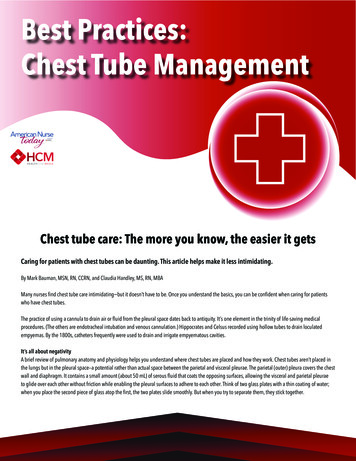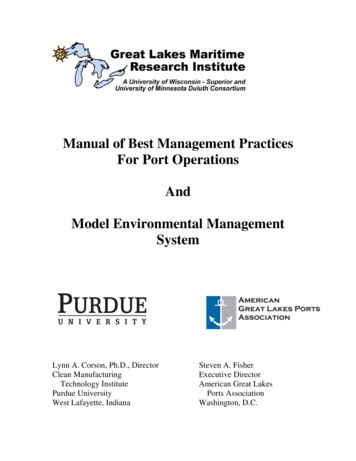
Transcription
Manual of Best Management PracticesFor Port OperationsAndModel Environmental ManagementSystemLynn A. Corson, Ph.D., DirectorClean ManufacturingTechnology InstitutePurdue UniversityWest Lafayette, IndianaSteven A. FisherExecutive DirectorAmerican Great LakesPorts AssociationWashington, D.C.
This report represents the results of research conducted by the authors and does notnecessarily represent the views or policies of the Great Lakes Maritime ResearchInstitute. This report does not contain a standard or specified technique. The authors andthe Great Lakes Maritime Research Institute do not endorse products or manufacturers.Trade or manufacturers’ names appear herein solely because they are considered essentialto this report.Research funded in part by the Great Lakes Maritime Research Institute.This study was supported by the U.S. Maritime AdministrationGrant # DTMA1-G-06-0051
AcknowledgementPartial support for the preparation of this report was provided by two grants from theGreat Lakes Maritime Research Institute, a University of Wisconsin-Superior andUniversity of Minnesota-Duluth Consortium, pursuant to Subcontract Numbers 040107GLMRI 2-1 Envi and 100107 GLMRI 2-2 Port.Considerable financial assistance was provided to this project by the American GreatLakes Ports Association through the commitment of personal time and travel of itsExecutive Director, Steven A. Fisher.The authors appreciate the cooperation of port authority personnel, terminal operators andtenants who granted interviews, conducted tours of their operations and providedinformation pertaining to the subject of this report.The Purdue University Co-Principal Investigator, Lynn A. Corson, Ph.D., acknowledgesthe valuable assistance provided by his Administrative Assistant, Gail A. Mills, inpreparing the various drafts of the report, researching/accessing government websites forstatutory citations and, generally, keeping the project on schedule.Please direct any questions or comments concerning this report to Lynn A. Corson, Ph.D.(corson@purdue.edu); Phone 765-463-4749; Fax 765-463-3795.2
Table of ContentsSection1.2.Introduction Page4Best Management Practices for Port Operations 1. Dry Bulk Storage & Handling . . 2. Liquid Bulk Storage & Transfer (Loading/Unloading) .3. Non-bulk Chemical Storage & Handling 4. Port Cargo Handling Equipment & Rail/TruckOperations Powered by Diesel Engines .5. Vehicle & Equipment Fueling .6. Port Authority Oversight of Tenant Activities throughLease Agreements .7. Management of Hazardous and Non-hazardous WasteGenerated by Port/Tenant Activities 8. General Operations that can Impact Neighboring Areas:Noise, Light, Odor, Trash, Dust .9. Building & Grounds Maintenance .10131824Sources of BMP Information (Compiled List of References) .603.Notable Environmental Projects at Great Lakes Ports .664.Environmental Management System Model for Great Lakes Ports Bibliography of Selected Environmental ManagementSources. . EMS Model Standard Operating Procedures . Appendices Environmental Management Program DocumentationForm . 733293337414551747590127153
IntroductionIn recent years, there has been increased public scrutiny of the maritime industryand its environmental impacts. Such scrutiny has not only come from environmentalorganizations, local governments, and media, but also from the industry’s customers.The nation’s marine transportation system provides an efficient means of movinglarge quantities of cargo with the least environmental impact. For example, a single1000-foot Great Lakes vessel can move the same quantity of cargo as 2800 trucks, orseven 100-car unit trains, resulting in less fuel consumption, fewer air emissions, and asmaller number of accidents.Despite these benefits, a variety of environmental challenges warrant attention.These include aquatic nuisance species, air emissions, storm water runoff, spill responseplanning and dredge material disposal. As competing transportation modes (such ashighway and rail) improve their own environmental performance, the maritime sectorwill need to engage in a process of continual improvement if it is to remain the mostenvironmentally friendly mode of transportation.Ports are a key component of the nation’s marine transportation industry. As theowners and managers of prime waterfront property, port authorities and port terminaloperators have a unique responsibility to adopt sustainable practices that preserve naturalresources while ensuring economic growth.BackgroundMany industries have found it helpful to utilize environmental managementsystems (EMS) to enhance environmental performance. An EMS is a management toolthat helps companies/organizations integrate environmental considerations into everydayoperations. In 2003, the American Association of Port Authorities (AAPA) and the U.S.Environmental Protection Agency (EPA) launched an EMS assistance project for ports.Managed by the Global Environment and Technology Foundation (GETF), the projectprovides assistance to public port agencies in developing comprehensive environmentalmanagement systems.While meritorious, the project is ill-suited to the small public port agencies on theGreat Lakes - some which have as few as four staff. Its cost ( 55,000) is beyond thebudgetary resources of many Great Lakes port authorities. For these reasons, only oneGreat Lakes port has participated in the program to date.This project seeks to address the need for a simplified environmental managementsystem approach for small port entities on the Great Lakes.4
ObjectivesThis project was initiated to accomplish several objectives:1) identify dominant environmental issues at Great Lakes ports2) catalogue best management practices (BMPs) for each issue3) design a simplified "EMS-like" tool for small ports with limited staff andbudgetary resources4) catalogue examples of environmental "success" stories at Great Lakes portsThe examination of port environmental issues was intentionally restricted to landbased operations; therefore, issues pertaining to vessel operations were not included inthe project.FundingThis project is a collaboration between the Clean Manufacturing TechnologyInstitute (CMTI), located at Purdue University in West Lafayette, Indiana and theAmerican Great Lakes Ports Association (AGLPA), located in Washington, DC. It wasfunded by two grants from the Great Lakes Maritime Research Institute (GLMRI), aUniversity of Wisconsin-Superior and University of Minnesota-Duluth Consortium.GLMRI is a National Maritime Enhancement Institute, so designated by the U.S.Secretary of Transportation.MethodologyThe core activity of the project team has been a series of site visits and interviewswith port officials at 12 locations in both the United States and Canada. Each visitincluded a briefing on port operations, a physical tour of the port area, interviews withport authority staff, and interviews with private terminal operators.Time and resources did not allow site visits to all Great Lakes harbors. Locationsselected were based on membership in - or affiliation with - the American Great LakesPorts Association. Further, a specific effort was made to visit both large and small portswhose operations were typical of those throughout the Great Lakes. Site visits weremade to the following locations:Chicago, Illinois - June 26, 2007Hamilton, Ontario - July 16-17, 2007Duluth, Minnesota - July 23-25, 2007Superior, Wisconsin - July 23-25, 2007Milwaukee, Wisconsin - October 10, 2007Cleveland, Ohio- May 13, 2008Erie, Pennsylvania - May 14, 20085
Green Bay, Wisconsin - August 13, 2008Toledo, Ohio - September 3, 2008Windsor, Ontario - October 7, 2008Detroit, Michigan - October 8, 2008Toronto, Ontario - October 20, 2008Seaports in the Great Lakes RegionFrom the earliest days of European settlement, the Great Lakes have been utilizedfor waterborne transportation. Many Great Lakes cities were founded as trading postsand evolved as a direct consequence of their proximity to water transport. Maritimecommerce has played an important role in the historic development of the region’seconomy and remains an important source of jobs today.There are 75 active ports on the U.S. side of the Great Lakes and an additional 29on the Canadian side. These facilities serve as the interface between waterbornetransportation and surface transportation such as highway and rail. In this regard, portfacilities facilitate the movement of goods within the region, and between the GreatLakes region and the world.Each year, roughly 220 million tons of cargo moves through Great Lakes ports.These products include iron ore, coal, limestone, salt, cement, fertilizer, asphalt,petroleum products, agricultural commodities, steel products and large equipment.What is a Port?In general, a port is one or more docks surrounded by a natural or man-madeharbor. Such harbors include a variety of infrastructure, such as breakwaters to protectthe harbor from excessive wave action, aids to navigation such as lighthouses and buoys,and an improved navigation channel to allow adequate underwater clearance for thepassage of vessels. A dock is a facility along the water’s edge at which ships are loadedor unloaded. Dock facilities would typically include an improved seawall to delineate theedge between land and water and provide a stable location to which a vessel can secureitself during cargo handling operations. Dock facilities would also typically includeequipment such as cranes, conveyors, fork-lifts and other equipment to facilitate theloading and unloading of cargo.Dock facilities might be exclusively committed to the business of cargo handling,or they may exist in support of a larger economic activity. For example, steel mills andpower plants often have their own dock facilities.Due to their unique geographic characteristics, historic development, local politicalstructure, constituent commodities, and ever-changing trade patterns, no two ports are thesame. To illustrate the variety of port facilities on the Great Lakes, the following sectionbriefly describes the locations visited as a part of this project.6
Port of Duluth dock facilities are located along the St. Louis River on the Minnesota side ofDuluth/Superior Harbor on the western tip of Lake Superior dock facilities are both publicly and privately owned the Duluth Seaway Port Authority serves as the local port agency cargoes include: coal, grain, iron ore, limestone, steel, general cargo/machinery,forest productsPort of Superior dock facilities are located along the St. Louis River on the Wisconsin side ofDuluth/Superior Harbor on the western tip of Lake Superior dock facilities are privately owned the City of Superior serves as the local port agency, primarily engaged in planningactivity cargoes include: coal, iron ore, grainPort of Green Bay dock facilities are located along the Fox River west of Green Bay on LakeMichigan dock facilities are privately owned Brown County Port and Solid Waste Department serves as the local port agency,primarily engaged in planning, port development, promotion, and public policyadvocacy cargoes include: coal, asphalt, salt, cement, pig iron, machinery, fuel oil,limestone, wood pulp/forest products, tallowPort of Milwaukee dock facilities are located along the Milwaukee River, Kinnickinnic River and onLake Michigan dock facilities are publicly and privately owned the City of Milwaukee serves as the local port agency cargoes include: coal, asphalt, salt, cement, grain, steel, machinery,passenger/auto ferry servicePort of Chicago dock facilities are located along the Chicago River in downtown Chicago, alongthe Calumet River on Chicago’s south side and along Lake Calumet. dock facilities are publicly and privately owned the Illinois International Port District serves as the local port agency cargoes include: coal, limestone, salt, grain, cement, petroleum products, steel,general cargo/machineryPort of Detroit dock facilities are located along the Detroit River and Rouge River dock facilities are publicly and privately owned7
the Detroit-Wayne County Port Authority serves as the local port agencycargoes include: iron ore, limestone, coal, general cargo/machinery, salt,petroleum products, cementPort of Toledo dock facilities are located along the Maumee River on the western edge of LakeErie dock facilities are publicly and privately owned the Toledo-Lucas County Port Authority serves as the local port agency cargoes include: iron ore, limestone, coal, grain, general cargo/machinery,cement, petroleum productsPort of Cleveland dock facilities are located on Lake Erie and along the Cuyahoga River dock facilities are publicly and privately owned the Cleveland-Cuyahoga County Port Authority serves as the local port agency cargoes include: iron ore, limestone, general cargo/machinery, salt, cement,sand/gravelPort of Erie dock facilities are located on Presque Isle Bay on Lake Erie dock facilities are publicly and privately owned the Erie-Western Pennsylvania Port Authority serves as the local port agency cargoes include: limestone, general cargo/machinery, sand/gravelPort of Windsor dock facilities are located along the Detroit River dock facilities are publicly and privately owned the Windsor Port Authority serves as the local port agency (under federal law) cargoes include: salt, cement, grain, general cargo/machineryPort of Hamilton dock facilities are located on Hamilton Harbour at the western end of LakeOntario dock facilities are publicly and privately owned the Hamilton Port Authority serves as the local port agency (under federal law) cargoes include: coal, iron ore, salt, sand/gravel, steel, grain, petroleum productsPort of Toronto dock facilities are l
port authority staff, and interviews with private terminal operators. Time and resources did not allow site visits to all Great Lakes harbors. Locations selected were based on membership in - or affiliation with - the American Great Lakes Ports Association. Further, a specific effort was made to visit both large and small ports whose operations were typical of those throughout the Great Lakes .



